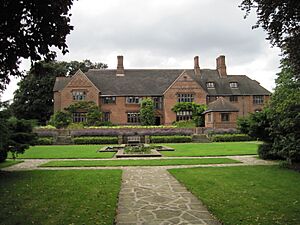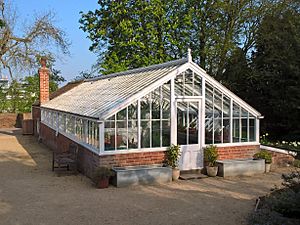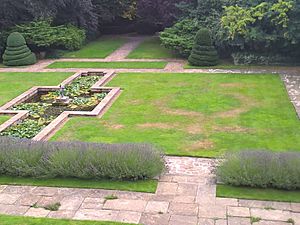Goddards House and Garden facts for kids

View of the south side of the house
|
|
| Lua error in Module:Location_map at line 420: attempt to index field 'wikibase' (a nil value). | |
| Established |
|
|---|---|
| Location | Dringhouses, York, England |
| Type | Arts and Crafts Historic House Museum |
| Visitors | 24,500 (2015/6) |
| Architect |
|
| Owner | National Trust |
| Public transit access | Buses from York Station |
| Nearest parking |
|
|
Listed Building – Grade I
|
|
| Official name | Goddards and Attached Gateway, Terrace and Loggia to Side and Rear |
| Designated | 24 June 1983 |
| Reference no. | 1256461 |
| Client | Noel Goddard Terry |
| Completed | 1927 |
|
Listed Building – Grade II*
|
|
| Official name | Number 25 Including Carriage Entrance |
| Designated | 24 June 1983 |
| Reference no. | 1256505 |
Goddards House and Garden is a special house in Dringhouses, York, England. It was built in 1927 for Noel and Kathleen Terry. The Terry family was famous for making chocolate! The house was designed by a local architect named Walter Brierley. The beautiful garden was created by George Dillistone.
Today, Goddards is owned by the National Trust. This group looks after important places in England. They bought Goddards in 1984. The garden is open for visitors at certain times of the year. The house itself is a very important historical building, known as a Grade I listed building. This means it's protected because of its special design and history.
Contents
House Design
Goddards was one of the last big projects for Walter Brierley. He was a famous architect who passed away in 1926 while the house was still being built. His own home was actually quite close to Goddards.
Special Features of the House
One cool thing about Goddards is the vaulted ceiling in the drawing room. This means the ceiling is curved like an arch. The fancy plasterwork on the ceilings was likely done by George P Bankart. Experts say Goddards is one of the best examples of Walter Brierley's work. It still has many of its original features. These include special Arts and Crafts wallpapers and wooden panels. The staircase also has beautiful oak carvings.
The outside of the house is made from handmade bricks. These bricks are arranged in cool patterns. The chimneys are also very decorative. These designs were typical of Brierley's buildings. The house was built by William Anelay. It cost about £25,980 in 1926, which was a lot of money back then! There were some delays, so the family moved in before it was completely finished. You can see copies of the original building plans inside the house.
Garden Design
In 1925, George Dillistone was hired to design the garden at Goddards. He was a landscape architect from Tunbridge Wells. He had also worked on other famous gardens. The garden design changed over several years. Plans were still being made as late as 1935.
Garden Areas
The four-acre garden at Goddards is divided into different sections. This was common for Arts and Crafts gardens. There's a terrace and several "rooms" made by shrubs and hedges. There's also a long border of flowering plants called a herbaceous border. All these parts show the Arts and Crafts style of the garden.
The garden used to have a tennis court, which was fixed up in 2016. There was also a bowling green that was used for croquet. The main part of the garden is a cross-shaped lily pool. Water flows into it from a semi-circular reflecting pool. This area was once a rose garden.
Beyond this, the garden slopes down towards York Racecourse. From there, you could walk to the Terry's chocolate factory. The factory's tall clock tower could be seen from the garden. Gardens in this style often become less formal the further you get from the house. Paths lead down through a rock garden at the very end.
Garden Wildlife
The garden was home to some interesting wildlife. This included a group of midwife toads. These toads are also called bell toads. In the early 1930s, some unusual pets lived there too. These included axolotls (a type of salamander) and green lizards. In 2016, the National Trust planned to replant the garden. They wanted it to look just like Dillistone's original designs from almost 90 years ago.
Carriage Entrance
Walter Brierley also designed the special entrance to Goddards. This is a Grade II* listed building. It's a red brick structure with small tower-like parts called turrets. It also has a garage for cars. This building was originally where the Terry family's chauffeur lived. It is still used as a home today.
The Terry Family at Goddards
Noel Terry (1889–1980) was the great-grandson of Joseph Terry. Joseph started the famous Terry's chocolate business. Noel grew up near Goddards. His wife, Kathleen Leetham (1892–1980), also lived nearby. Her family owned a large flour-milling business in York.
Noel and Kathleen got married in 1915. Soon after, Noel went to France to fight in the First World War. He was injured in 1916. After he came home, they started their family. By 1925, they had two sons, Peter and Kenneth, and a daughter, Betty. They needed a bigger house, so Goddards became their family home in 1927. Their youngest son, Richard, was born there the next year. The house was named Goddards after Noel Terry's grandmother, Frances Goddard.
In the 1930s, Noel became a managing director at Terry's. This was when the company created two of its most famous products: Terry's All Gold and the Terry's Chocolate Orange. During the Second World War, Noel helped as a Controller for the Royal Observer Corps. He received an award in 1943 for his work. His son Kenneth served in the RAF and also received an award in 1942. Sadly, Kenneth passed away in 1944. He is remembered on the local war memorial. Noel continued to work at Terry's until 1970. His son Peter later became a deputy managing director.
Even though Goddards was built in the Arts and Crafts style, Noel Terry filled it with many old Georgian furniture pieces and clocks. He loved collecting antiques. His father-in-law, who collected porcelain and jade, might have inspired him. Noel was also very interested in history. He was involved with the York Civic Trust for many years. After Noel and Kathleen passed away in 1980, Noel's collection was shown at Fairfax House in York. This is a museum in a Georgian-style house.
National Trust Era

When the National Trust first took over Goddards, they used it as offices. It wasn't open to visitors at first. However, the garden opened to the public in 2006. The house itself opened in 2012.
The rooms in the house were set up to look like they did in the 1930s. This was when the house was busiest and the Terry's chocolate business was doing very well. Terry's also had its own tearoom and shop in York. The cakes from their shop inspired the food served in the dining room at Goddards. You could see displays of old Terry's chocolate packaging. There was even a small model of the Terry's factory.
Goddards was a finalist for a tourism award in 2014 and 2015. More and more people visited the house. In 2011, before the house opened, about 5,608 people visited. By 2015/16, that number grew to 24,500! Because of this, the National Trust planned to make the eating areas bigger. They also wanted to show more of their chocolate collection. The property closed in late 2016 for repairs and reopened in April 2017. It closed again to the public in March 2020. Since then, only the gardens have been open on certain days for visitors.



